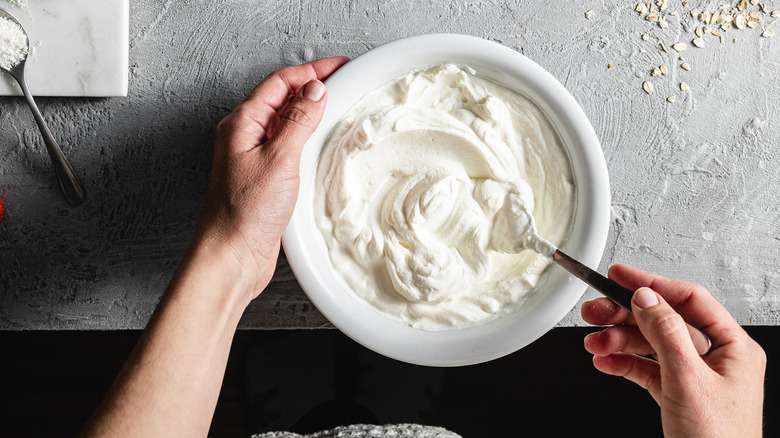The Clever Way Alton Brown Uses Heating Pads When Making Fresh Yogurt
"Food science" is its own area of study for a reason. From fermentation to pasteurization to whatever the process of producing koji is, the intersection of gastronomy and alchemy is a labyrinthian entity unto itself. Here to help untangle this web is self-proclaimed "foodist" Alton Brown — in this case, when it comes to yogurt. Believe it or not, it's fairly easy to save a fat chunk of money, skip the grocery line, and start making batches of healthy, homemade yogurt yourself, additive and preservative-free.
When you think about "mystifying" foods, there's probably a good chance that mild yogurt is pretty far down on the list. But yogurt is more a product of science than culinary know-how. As counterculture icon and anti-war activist Abbie Hoffman succinctly explained in his magnum opus "Steal This Book," "Yogurt is a bacteria that spreads throughout a suitable culture at the correct temperature." The book's section on thrifty meals includes a recipe for homemade yogurt, and both Hoffman and Brown agree: A heating element is essential to maintain enough warmth for the bacteria to grow.
However, for the self-empowered home cook, exactly which tool you use for a heating element can be decided with a little liberty. Your most effective yogurt-making tool might actually be stashed in your medicine cabinet. When celebrity chef and television personality Alton Brown is whipping up a batch of homemade yogurt, he uses a heating pad. It's not just for aches and pains, after all.
The unlikely tool for fail-safe fermentation
To get the bacteria-growth process rolling for the recipe he shared with Food Network, Alton Brown starts with ½ cup of plain, room-temperature yogurt. Then, to pasteurize the yogurt, he heats 2% milk, powdered milk, and a little honey in a saucepan to 120 degrees. This liquid is the culture in which the yogurt bacteria will multiply. After removing the liquid from the heat, he transfers it to a plastic container and adds in the ½ cup of yogurt. Then, the showstopping step: Brown turns a heating pad to medium heat and places the warm pad inside a narrow wine bucket, sticking the liquid-filled container on top to ferment.
The technique, Brown explains, mimics the traditional Turkish method of making homemade yogurt. In other words, folks have been doing this for ages, and it's a great way for intrepid foodies to embark on their maiden voyages into the world of food science. (Who knows? You might even dry-cure a whole fish next.)
If you don't have a heating pad, all hope is not lost. Abbie Hoffman suggested placing the liquid-filled container on top of a radiator, in a sunny window, or inside a warmed, turned-off oven for about 8 hours. "The bowl simply grows until the whole bowl is yogurt. Yippie!" You can even make yogurt in your Instant Pot. As you enjoy your scientific creation, just remember to leave a little yogurt left in the bottom of the bowl to start the next batch.

